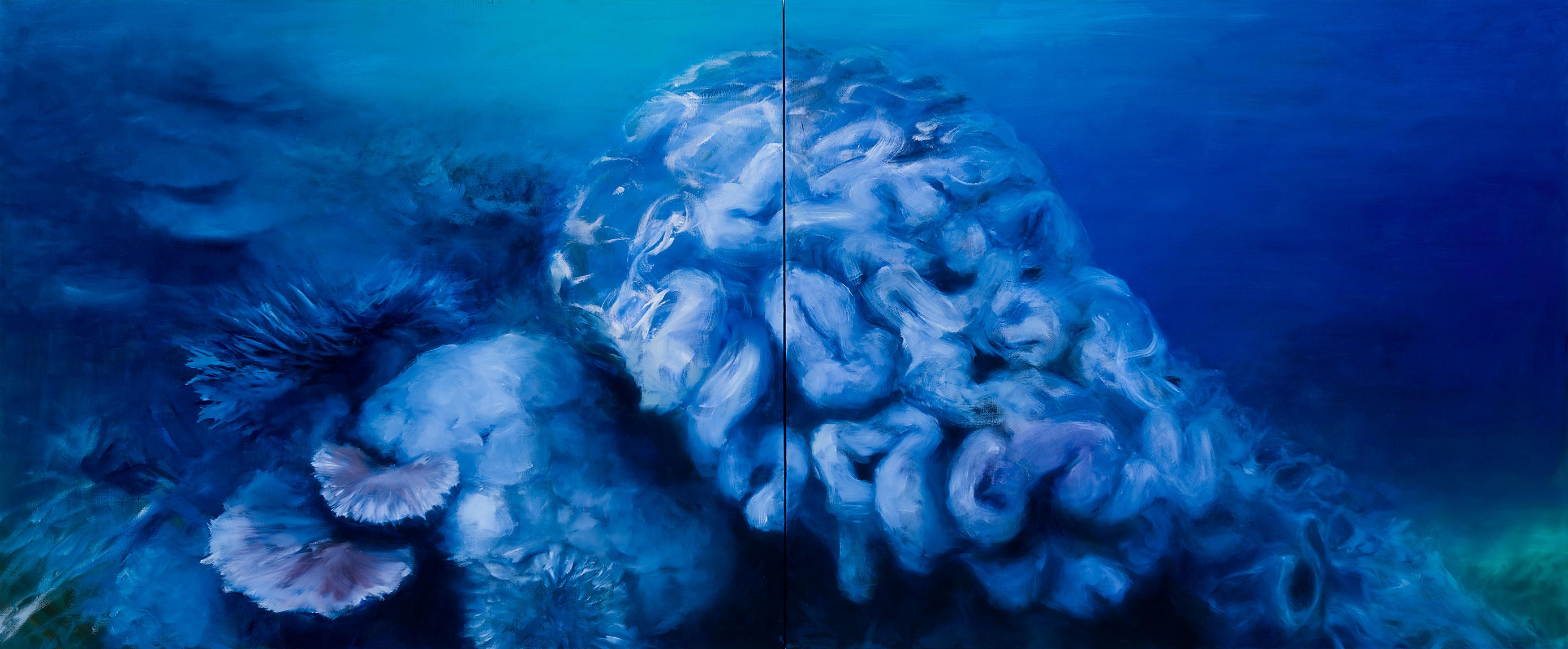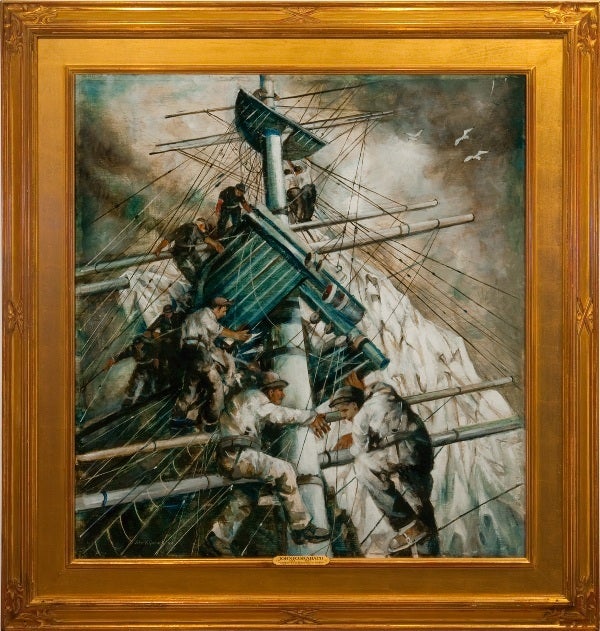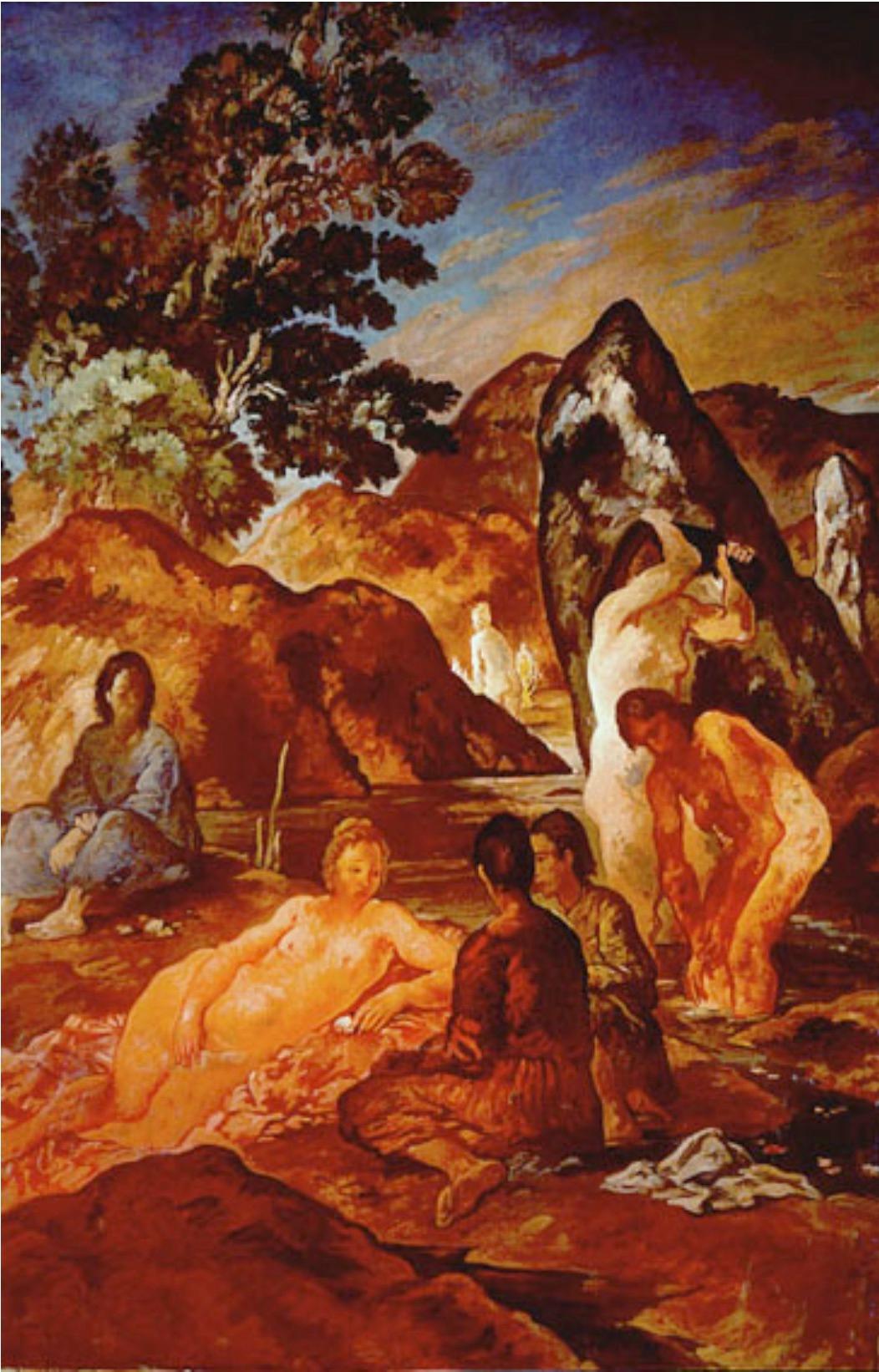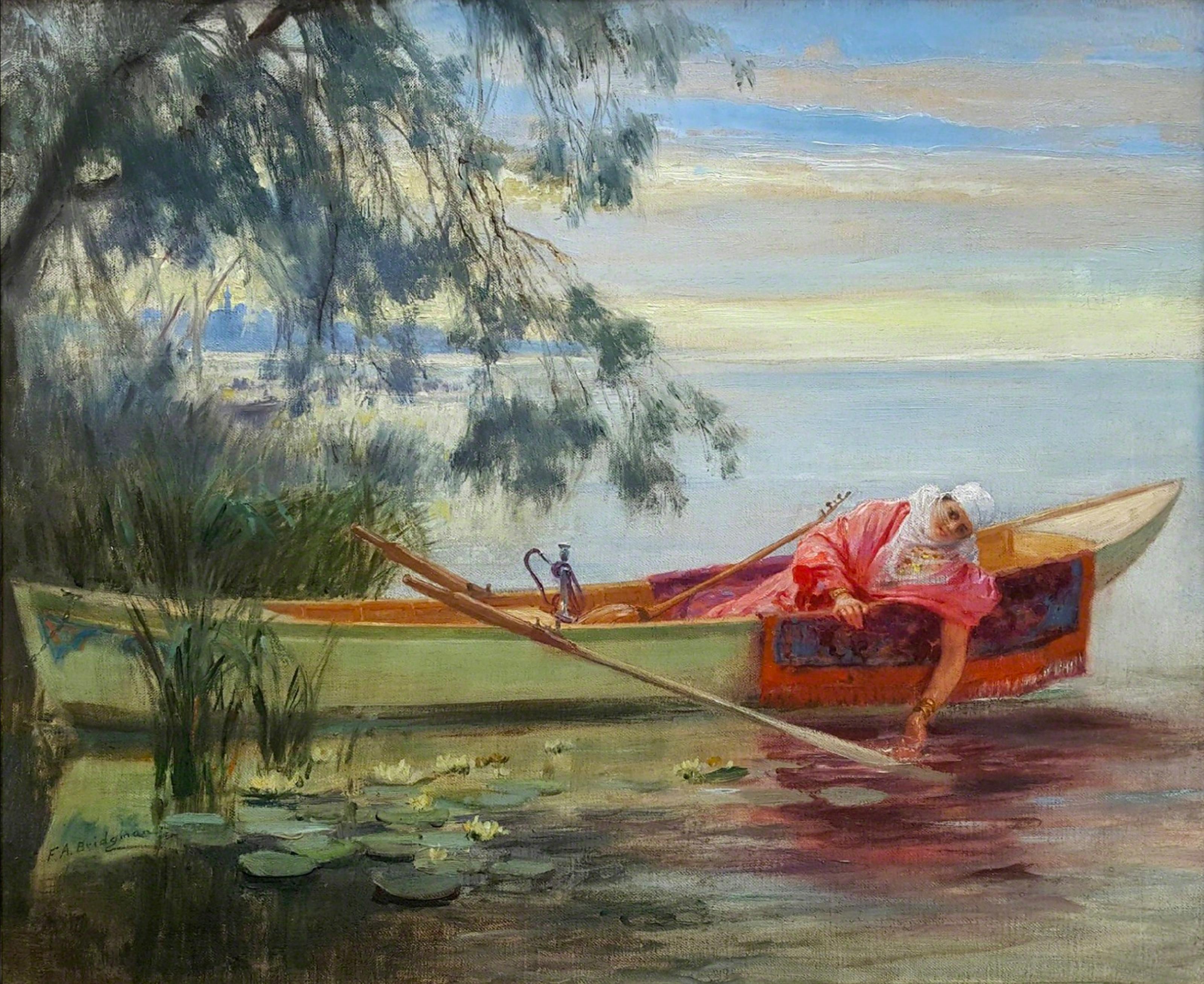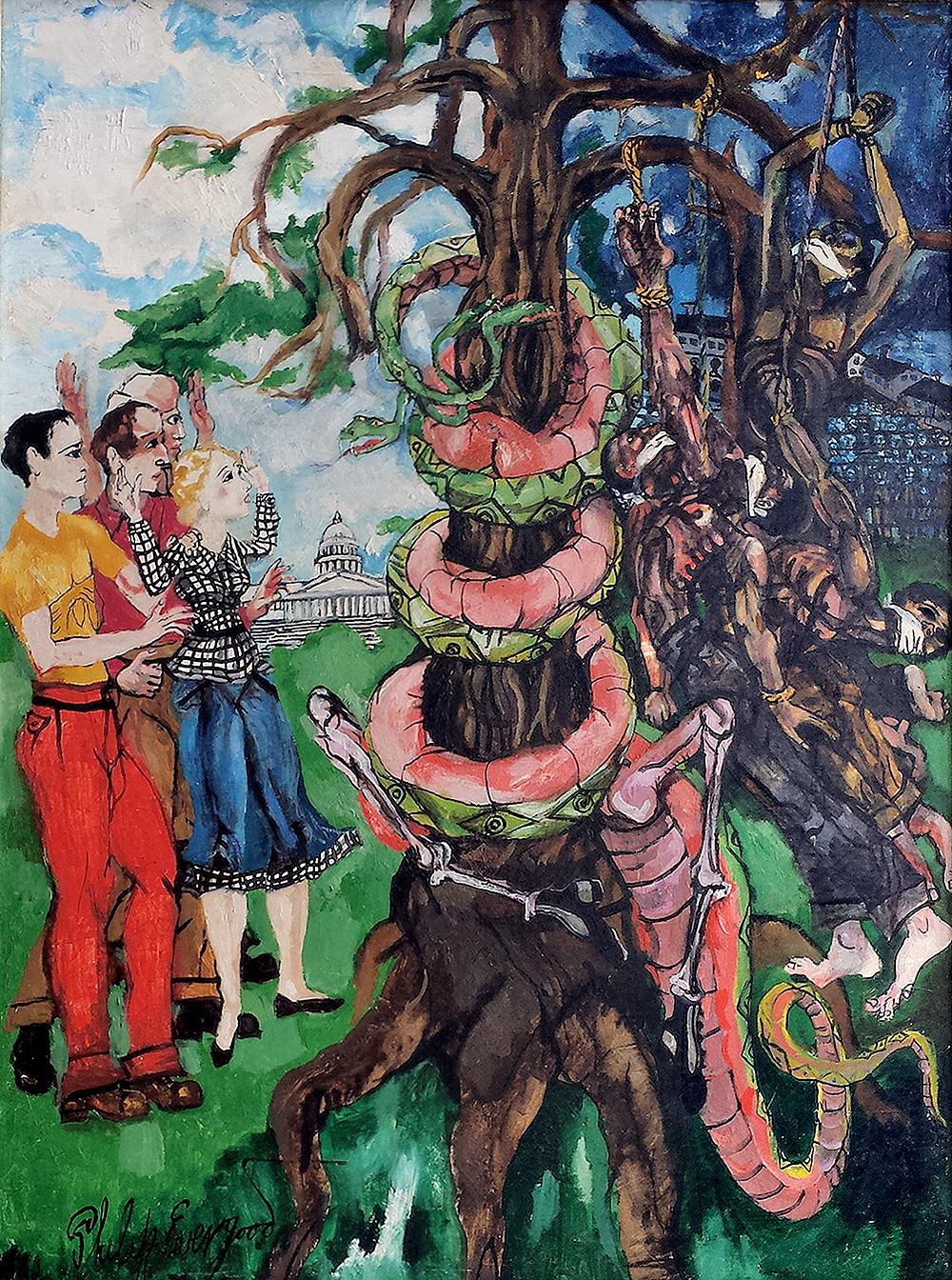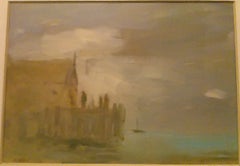
Seymour Remenick Seascape Marine Painting
View Similar Items
Want more images or videos?
Request additional images or videos from the seller
1 of 8
Seymour RemenickSeymour Remenick Seascape Marine Painting
About the Item
- Creator:Seymour Remenick (1923-1999, American)
- Dimensions:Height: 13 in (33.02 cm)Width: 16 in (40.64 cm)
- Period:
- Condition:good.
- Gallery Location:Surfside, FL
- Reference Number:1stDibs: G14030638218
About the Seller
4.9
Platinum Seller
These expertly vetted sellers are 1stDibs' most experienced sellers and are rated highest by our customers.
Established in 1995
1stDibs seller since 2014
1,552 sales on 1stDibs
Typical response time: 1 hour
More From This SellerView All
- 1927 Oil Painting Eiffel Tower Paris American Modernist Wpa Artist Morris KantorBy Morris KantorLocated in Surfside, FLMorris Kantor New York (1896 - 1974) Paris from the Ile St. Louis, 1927 (view of Eiffel Tower) Oil painting on canvas Hand Signed lower left. Provenance: Hirshhorn Museum and Sculpture Garden, Smithsonian Institution ( bears label verso) Size: 20 3/4"H x 28 1/8"W (sight), 28.75 "H x 36"W (framed) Morris Kantor (Belarusian: Морыс Кантор) (1896-1974) was a Russian Empire-born American painter based in the New York City area. Born in Minsk on April 15, 1896, Kantor was brought to the United States in 1906 at age 10, in order to join his father who had previously relocated to the states. He made his home in West Nyack, New York for much of his life, and died there in 1974. He produced a prolific and diverse body of work, much of it in the form of paintings, which is distinguished by its stylistic variety over his long career. Perhaps his most widely recognized work is the iconic painting "Baseball At Night", which depicts an early night baseball game played under artificial electric light. Although he is best known for his paintings executed in a realistic manner, over the course of his life he also spent time working in styles such as Cubism and Futurism, and produced a number of abstract or non-figural works. A famous cubist, Futurist, painting of his "Orchestra" brought over 500,000$ at Christie's auction house in 2018 Kantor found employment in the Garment District upon his arrival in New York City, and was not able to begin formal art studies until 1916, when he began courses at the now-defunct Independent School of Art. He studied landscape painting with Homer Boss (1882-1956). In 1928, after returning to New York City from a year in Paris, Kantor developed a style in which he combined Realism with Fantasy, often taking the streets of New York as his subject matter. He did some moody Surrealist Nude paintings and fantasy scenes. In the 1940's he turned towards figural studies. Later in his career, Kantor himself was an instructor at the Cooper Union and also at the Art Students League of New York in the 1940s, and taught many pupils who later became famous artists in their own right, such as Knox Martin, Robert Rauschenberg, Sigmund Abeles and Susan Weil...Category
1920s American Modern Landscape Paintings
MaterialsCanvas, Oil
- Israeli Modernist Watercolor Landscape Signed in HebrewLocated in Surfside, FLIn this piece the artist choice of colors is muted, and there is a deft blending of them. Israel has had a Vibrant Folk Art, Naive art scene for a long time now, artists like Yisrael Paldi, Nahum Guttman, Reuven Rubin and even Yefim Ladizhinsky had naive periods. The most well know of the strict naive artists are Shalom of Safed, Irene Awret, Gabriel Cohen, Natan Heber, Michael Falk and Kopel Gurwin. Naïve art is any form of visual art that is created by a person who lacks the formal education and training that a professional artist undergoes (in anatomy, art history, technique, perspective, ways of seeing). Unlike folk art, naïve art does not necessarily evince a distinct cultural context or tradition. Naïve art is recognized, and often imitated, for its childlike simplicity and frankness. Paintings of this kind typically have a flat rendering style with a rudimentary expression of perspective. One particularly influential painter of "naïve art" was Henri Rousseau (1844–1910), a French Post-Impressionist who was discovered by Pablo Picasso. Naïve art is often seen as outsider art that is by someone without formal (or little) training or degree. While this was true before the twentieth century, there are now academies for naïve art. Naïve art is now a fully recognized art genre, represented in art galleries worldwide. Museums devoted to naïve art now exist in Kecskemét, Hungary; Riga, Latvia; Jaen, Spain; Rio de Janeiro, Brasil; Vicq France and Paris. "Primitive art" is another term often applied to art by those without formal training, but is historically more often applied to work from certain cultures that have been judged socially or technologically "primitive" by Western academia, such as Native American, sub saharan African or Pacific Island art (see Tribal art). This is distinguished from the self-conscious, "primitive" inspired movement primitivism. Another term related to (but not completely synonymous with) naïve art is folk art. There also exist the terms "naïvism" and "primitivism" which are usually applied to professional painters working in the style of naïve art (like Paul Gauguin, Mikhail Larionov, Paul Klee). At all events, naive art can be regarded as having occupied an "official" position in the annals of twentieth-century art since - at the very latest - the publication of the Der Blaue Reiter, an almanac in 1912. Wassily Kandinsky and Franz Marc, who brought out the almanac, presented 6 reproductions of paintings by le Douanier' Rousseau (Henri Rousseau), comparing them with other pictorial examples. However, most experts agree that the year that naive art was "discovered" was 1885, when the painter Paul Signac became aware of the talents of Henri Rousseau and set about organizing exhibitions of his work in a number of prestigious galleries. The Earth Group (Grupa Zemlja) were Croatian artists, architects and intellectuals active in Zagreb from 1929 to 1935. The group included the painters Krsto Hegedušić, Edo Kovačević, Omer Mujadžić, Kamilo Ružička, Ivan Tabaković, and Oton Postružnik, the sculptors Antun Augustinčić, Frano Kršinić, and the architect Drago Ibler. Art brut, primitive art, primitive, art naïf, naïve art. Outsider art. A term applied to Yugoslav (Croatian) naive painters working in or around the village of Hlebine, near the Hungarian border, from about 1930. Some of the best known naive artists are Dragan Gaži, Ivan Generalić, Josip Generalić, Krsto Hegedušić, Mijo Kovačić, Ivan Lacković-Croata, Franjo Mraz, Ivan Večenaj and Mirko Virius. Camille Bombois (1883–1970) Ferdinand Cheval, known as 'le facteur Cheval' (1836–1924) Henry Darger (1892–1973) L. S. Lowry (1887–1976) Grandma Moses, Anna Mary Robertson (1860–1961) Nikifor (1895–1968) Poland, Horace Pippin (1888–1946) Jon Serl (1894-1993) United States Alfred Wallis (1855–1942) Scottie Wilson (1890–1972) Gesner Abelard (b. 1922) Jan Balet (1913–2009) Michel Delacroix (b. 1933) France Howard Finster (1916–2001) Ivan Rabuzin (1921–2008) Spontaneous Art Museum in Brussels Art en Marge Museum in Brussels MADmusée in Liege International Museum of Naive Art of Brazil in Cosme Velho, Rio de Janeiro Gallery Jacques Ardies in São Paulo Musée international d'art naïf de Magog in Magog Croatian Museum of Naïve Art in Zagreb Gallery of Croatian Naïve Art...Category
1980s Modern Figurative Paintings
MaterialsWatercolor
- Antique Oil Painting Of Jerusalem Ascent to Old City WallsLocated in Surfside, FLThis s an older piece signed with initials by artist JS. I would date this as late 19th Century or early 20th C.Category
Late 19th Century Impressionist Landscape Paintings
MaterialsOil
- French Folk Art Naive Oil Painting Workers in Vineyard, Les Vignes aux GitansLocated in Surfside, FLMax Savy Oil on canvas painting depicting a village scene with winemakers in a vineyard by artist Max Savy (French, b. 1918). Signed in the lower right. Frame measures 24.5 inches x 28 inches. canvas is 18 X 22 inches., Perfect for a wine cellar or cave. Max Savy (French, 1918-2010) painted scenes of everyday life in the French Corbieres region, which garnered much success during his life. Though the artist remained silent about his early life, it's known his father instilled in him a belief in the humanist socialism philosophy of French Socialist Party leader, Jean Jaures. In 1938, at age 20, he moved to Carcassonne to attend school. There, he married and settled into a teaching position, joining the French Resistance during World War II and earning the Cross of the Combatant. After the war, he created the work for which he is most admired. Max Savy paintings are part of France's heritage collection, and the artist became a knight of the National Order of Merit in 1973. Max Savy's paintings and artworks include scenes of peasants in the fields. Max Savy was active/lived in France. Max Savy is known for folk art style painting of village architecture, vintners, figures in landscape, wine makers, marine scenes. His work is similar in style to the naive, folk art paintings of Michel Delacroix and Fanch Ledan. This is quite similar to a work I had titled "Les Vignes Aux Gitans" (the gypsy grape vines) So i assume this is also a vineyard painting...Category
Mid-20th Century Folk Art Landscape Paintings
MaterialsCanvas, Oil
- Romanian Israeli Modernist Oil Painting Expressionist Figures Mothers and BabiesBy Risa Propst KraidLocated in Surfside, FLRisa Propst Kraid (Romanian - Israeli, 1894-1983) Jewish Israeli Woman artist. enigmatic picture of either women picnicking or refugees huddling together. Painting and Sculpture We...Category
1960s Expressionist Figurative Paintings
MaterialsCanvas, Oil
- Simka Simkhovitch WPA Artist Oil Painting Gouache American Modernist PowerlineBy Simka SimkhovitchLocated in Surfside, FLSimka Simkhovitch (Russian/American 1893 - 1949) This came with a small grouping from the artist's family, some were hand signed some were not. These were studies for larger paintings. Simka Simkhovitch (Симха Файбусович Симхович) (aka Simka Faibusovich Simkhovich) (Novozybkov, Russia May 21, 1885 O.S./June 2, 1885 N.S.—Greenwich, Connecticut February 25, 1949) was a Ukrainian-Russian Jewish artist and immigrant to the United States. He painted theater scenery in his early career and then had several showings in galleries in New York City. Winning Works Progress Administration (WPA) commissions in the 1930s, he completed murals for the post offices in Jackson, Mississippi and Beaufort, North Carolina. His works are in the permanent collections of the Dallas Museum of Art, the National Museum of American Art and the Whitney Museum of American Art. Born outside Kyiv (Petrograd Ukraine) into a Jewish family who owned a small department store. During a severe case of measles when he was seven, Simcha Simchovitch sketched the views outside his window and decided to become an artist, over his father's objections. Beginning in 1905, he studied at the Grekov Odessa Art School and upon completion of his studies in 1911 received a recommendation to be admitted to the Imperial Academy of Arts. Though he enrolled to begin classes in architecture, painting, and sculpture at the Imperial Academy, he was dropped from the school roster in December because of the quota on the number of Jewish students and drafted into the army. Simchovitch served as a private in the 175th Infantry Regiment Baturyn [ru] until his demobilization in 1912. Re-enrolling in the Imperial Academy, he audited classes. Simka Simkhovitch exhibited paintings and sculptures in 1918 as part of an exhibition of Jewish artists and in 1919 placed 1st in the competition "The Great Russian Revolution" with a painting called "Russian Revolution" which was hung in the State Museum of Revolution. In 1922, Simkha Simkhovitch exhibited at the International Book Fair in Florence (Italian: Fiera Internazionale del Libro di Firenze). In 1924, Simkhovitch came to the United States to make illustrations for Soviet textbooks and decided to immigrate instead. Initially he supported himself by doing commercial art and a few portrait commissions. In 1927, he was hired to paint a screen for a scene in the play "The Command to Love" by Fritz Gottwald and Rudolph Lothar which was playing at the Longacre Theatre on Broadway. Art dealers began clamoring for the screen and Simkhovitch began a career as a screen painter for the theater. Catching the attention of the screenwriter, Ernest Pascal, he worked as an illustrator for Pascal, who then introduced him to gallery owner, Marie Sterner. Simkhovitch's works appeared at the Marie Sterner Gallery beginning with a 1927 exhibit and were repeated the following year. Simkhovitch had an exhibit in 1929 at Sterner's on circus paintings. In 1931, he held a showing of works at the Helen Hackett Gallery, in New York City and later that same year he was one of the featured artists of a special exhibit in San Francisco at the California Palace of the Legion of Honor in Lincoln Park. The exhibit was coordinated by Marie Sterner and included four watercolors, including one titled "Nudes". He is of the generation of Russian Soviet artists such as Isaac Pailes, Serge Charchoune, Marc Chagall, Chana Orloff, Isaac Ilyich Levitan, and Ossip Zadkine. In 1936, Simkhovitch was selected to complete the mural for the WPA Post office project in Jackson, Mississippi. The mural was hung in the post office and courthouse in 1938 depicted a plantation theme. Painted on the wall behind the judge’s bench, “Pursuits of Life in Mississippi”, a depiction of black workers engaged in manual labor amid scenes of white professionals and socialites, was eventually covered over in later years during renovations due to its stereotypical African American imagery. Simka painted what he thought was typical of Jackson. His impression of pre-civil rights Mississippi was evidently Greek Revival column houses, weeping willow trees, working class families, and the oppression of African Americans. He painted African American men picking cotton, while a white man took account of the harvest and a white judge advised a white family, calling it Pursuits of Life in Mississippi. Though clearly endorsed by the government and initially generally well-received, the mural soon raised concerns with locals as the climate toward racial segregation began to change. The main concern was whether depictions that show African Americans in subjugated societal roles should be featured in a courtroom. The following year, his painting "Holiday" won praise at an exhibition in Lincoln, Nebraska. In 1940, Simkhovitch's second WPA post office project was completed when four murals, "The Cape Lookout Lighthouse and the Orville W. Mail Boat", "The Wreck of the Crissie Wright", "Sand Ponies" and "Canada Geese" were installed in Beaufort, North Carolina. The works were commissioned in 1938 and did not generate the controversy that the Jackson mural had. The main mural is "The Wreck of the Crissie Wright" and depicts a shipwreck which had occurred in Beaufort in 1866. "The Cape Lookout Lighthouse and the Orville W. Mail Boat" depicted the lighthouse built in 1859 and the mail boat that was running mail during the time which Simkhovitch was there. The boat ran mail for the area until 1957. "Sand Ponies" shows the wild horses common to the North Carolina barrier islands and "Canada Geese" showed the importance of hunting and fishing in the area. All four murals were restored in the 1990s by Elisabeth Speight, daughter of two other WPA muralists, Francis Speight...Category
1930s American Modern Landscape Paintings
MaterialsGouache, Oil, Board
You May Also Like
- "Ebbing Reef" Corals, Large Scale Contemporary Seascape Oil Painting (deep blue)By Karen MarstonLocated in New York, NY60"x144" large scale painting, oil on canvas, created on two joined canvases. The deep blue palette gives a sense of underwater space in this grand depiction of coral reefs. Artist, Karen Marston presents this endangered species in a grand scale to show its beauty and importance to our environment. Karen Marston is a painter living and working in Brooklyn, NY. Her work has been seen in a number of solo exhibitions in New York City. In addition to her 2018 show Harbingers, at the Owen James Gallery in Soho, other recent solos include: 2017’s To Embrace the Whole Sky with the Mind, at Station Independent Projects on the Lower East Side, Demeter’s Wrath in 2016 at the Owen James Gallery and Storm Watch...Category
2010s Contemporary Landscape Paintings
MaterialsOil, Canvas
- 'Agay, le château et le Sémaphore'. Oil on canvas. Signed.By Armand GuillauminLocated in Paris, FR'Agay, le château et le Sémaphore'. Oil on canvas. +/- 1922 Signed lower right Measurements : 60 x 73 cm. This painting will be recorded in the second volume of the Catalogue Raisonn...Category
1920s Impressionist Landscape Paintings
MaterialsOil
- "Valencian Flower Pickers ", Early 20th Century Oil on Canvas by José MongrellLocated in Madrid, ESJOSÉ MONGRELL Spanish, 1870 - 1937 VALENCIAN FLOWER PICKERS signed “J. Mongrell” lower left oil on canvas 29-1/4 x 45 inches (74 x 114 cm.) framed: 42-3/...Category
1910s Realist Figurative Paintings
MaterialsCanvas, Oil
- "After the Storm"By John R. GrabachLocated in Lambertville, NJSigned LL John Grabach was a highly regarded New Jersey artist, teacher and author of a classic text, How to Draw the Human Figure. He was born in Massachusetts, and with his widow...Category
20th Century Ashcan School Figurative Paintings
MaterialsOil, Panel
- Luis Miguel Valdes, "Symphony Always Havana", 2016, canvas 118x393inBy Luis Miguel ValdesLocated in Miami, FLLuis Miguel Valdes (Cuban, 1949) "Symphony Always Havana", 2016 Charcoal on Canvas 118 × 393 in (299.7 × 998.2 cm) UnframedCategory
2010s Contemporary Figurative Paintings
MaterialsCanvas, Charcoal, Varnish
- Bords du Loing by Alfred Sisley - Oil, landscape paintingBy Alfred SisleyLocated in London, GB*THIS PRICE INCLUDES 5% IMPORT DUTY APPLICABLE IF THE WORK REMAINS IN THE UK ONLY. Bords du Loing by Alfred Sisley (1839-1899) Oil on canvas 46.1 x 55.7 cm (18¹/₈ x 21⁷/₈ inches) S...Category
1890s Post-Impressionist Landscape Paintings
MaterialsCanvas, Oil
